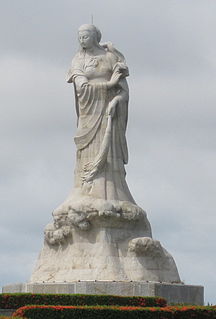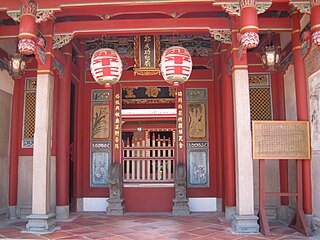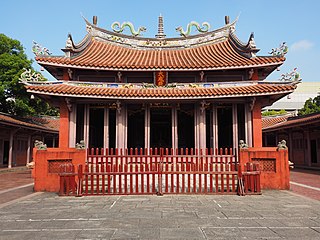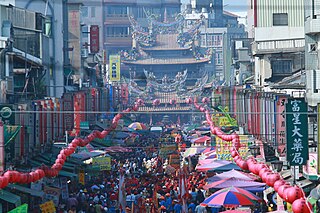
Zheng Chenggong,Prince of Yanping,better known internationally as Koxinga or Cheng Ch'eng-kung,was a Ming loyalist who resisted the Qing conquest of China in the 17th century,fighting them on China's southeastern coast.

Mazu is a Chinese sea goddess also known by several other names and titles. She is the deified form of the legendary figure Lin Mo or Lin Moniang,a Fukianese shamaness whose life span is traditionally dated from 960 to 987. Revered after her death as a tutelary deity of seafarers,including fishermen and sailors,her worship spread throughout China's coastal regions and overseas Chinese communities throughout Southeast Asia. She was thought to roam the seas,protecting her believers through miraculous interventions. She is now generally regarded by her believers as a powerful and benevolent Queen of Heaven. Mazu worship is popular in Taiwan as large numbers of early immigrants to Taiwan were Min People;her temple festival is a major event in the country,with the largest celebrations around her temples at Dajia and Beigang.

Anping District is a district of Tainan,Taiwan. In March 2012,it was named one of the Top 10 Small Tourist Towns by the Tourism Bureau of Taiwan.

Koxinga Ancestral Shrine is a family shrine built in West Central District,Tainan,Taiwan in 1663 by Zheng Jing,to worship his father Koxinga.

The Tainan Confucian Temple or Quan Tai Shou Xue,is a Confucian temple on Nanmen Road (南門路) in West Central District,Tainan,Taiwan.

Tainan,officially Tainan City,is a special municipality in southern Taiwan facing the Taiwan Strait on its western coast. Tainan is the oldest city on the island and also commonly known as the "Capital City" for its over 200 years of history as the capital of Taiwan under Koxinga and later Qing rule. Tainan's complex history of comebacks,redefinitions and renewals inspired its popular nickname "the Phoenix City". Tainan is classified as a "Sufficiency" level global city by the Globalization and World Cities Research Network.

The Chaotian or Chaotien Temple,officially the Chao-Tian Temple,is a temple to the Chinese Goddess Mazu in Beigang Township,Yunlin County,Taiwan. Constructed in 1700,it became one of the most important Mazu temples in Taiwan and is known for its extravagant temple architecture. It is visited by more than a million pilgrims every year.
The Luerhmen History and Culture Museum is a historical and cultural complex in Annan District,Tainan,Taiwan.
Tainan Prefecture was a prefecture of Taiwan under Qing rule. The prefecture was established by the Qing dynasty government in 1887,when Fokien-Taiwan Province was established. The prefecture included the districts/counties of Anping,Kagi,Fengshan,and Hengchun,and the sub-prefecture of Penghu.

The Dajia Jenn Lann Temple,also known as the Zhenlan or Mazu Temple,is a temple dedicated to the Chinese Goddess Mazu,the Goddess of Sea and Patron Deity of fishermen,sailors and any occupations related to sea/ocean. The temple is located in the Dajia District of Taichung,Taiwan. It is known for being the start of the Dajia Mazu Pilgrimage,an annual celebration of the sea goddess.

The Tianfei Palace,officially the Mazu Cultural Palace and also known as the Tianhou Palace,is a restored temple of the Chinese sea-goddess Mazu,the deified form of the medieval Fujianese shamaness Lin Moniang,located in Fangta Park in Songjiang,Shanghai,in eastern China. Officially classified as a museum,the Tianfei Palace conducts Mazuist rites twice a year,on the traditional anniversaries of Lin Moniang's birth and death. It is also used as the site for an annual commemoration of Songjiang's city god Li Daiwen.

The Tianhou or Mazu Temple is a temple to the Goddess Mazu,the Chinese Goddess of Sea and Patron Deity of fishermen,sailors and any occupations related to sea/ocean. It is located in Xinwu District,Taoyuan City,Taiwan.

The Grand Matsu Temple,also known as the Datianhou or Great Queen of Heaven Temple,is a temple to the Chinese Goddess Mazu,who is the Goddess of Sea and Patron Deity of fishermen,sailors and any occupations related to sea/ocean. The temple is located in the West Central District of Tainan on Taiwan.

The Lukang Tianhou Temple,also known as the Lukang Mazu Temple,is a Chinese temple dedicated to the Chinese Goddess Mazu,the Goddess of Sea and Patron Deity of fishermen,sailors and any occupations related to sea/ocean. The temple is located at 430 Zhongshan Road in Lukang Township,Changhua County,Taiwan. It is one of the island's most famous and popular Mazu temples.

The Penghu Tianhou Temple is a temple dedicated to the Chinese Goddess Mazu,who is the Goddess of Sea and Patron Deity of fishermen,sailors and any occupations related to sea/ocean. It is located at 1 Zhengyi Street (正義街1號),Magong City,Penghu,Taiwan. It is usually accounted the oldest Mazu temple in Taiwan and,despite the present differences in characters,is the namesake of the surrounding city of Magong. It is open from 7:00 am to 5:30 pm daily.
The architecture of Taiwan can be traced back to stilt housing of the aborigines in prehistoric times;to the building of fortresses and churches in the north and south used to colonize and convert the inhabitants during the Dutch and Spanish period;the Tungning period when Taiwan was a base of anti-Qing sentiment and Minnan-style architecture was introduced;in Qing dynasty period,a mix of Chinese and Western architecture appeared and artillery battery flourished during Qing's Self-Strengthening Movement;During the Japanese rule of Taiwan,the Minnan,Japanese and Western culture were main influencers in architectural designs and saw the introduction and use of reinforced concrete. Due to excessive Westernization as a colony,after the retrocession of Taiwan to the Republic of China in 1945 from Japan at the end of World War II,Chinese classical style became popular and entered into international mainstream as a postmodern design style. Today,Taiwanese architecture has undergone much diversification,every style of architecture can be seen.
Events from the year 1683 in China.

Lecheng Temple is a temple located in East District,Taichung City,Taiwan. Mazu is the main Deity worshipped in the temple,and the Goddess of Sea is also known as the "Hanxi Mazu" after the nearby Han River.


















